African elephant
| African elephant[1] Temporal range: Middle Pliocene-Holocene | |
|---|---|
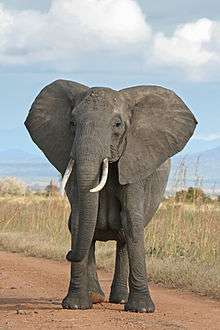 | |
| African bush elephant, Loxodonta africana, in Mikumi National Park, Tanzania | |
| Scientific classification | |
| Kingdom: | Animalia |
| Phylum: | Chordata |
| Class: | Mammalia |
| Order: | Proboscidea |
| Family: | Elephantidae |
| Genus: | Loxodonta Anonymous, 1827 |
| Species | |
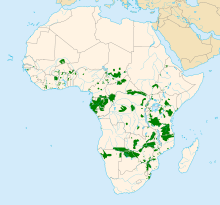 | |
| Distribution of Loxodonta (2007) | |
African elephants are elephants of the genus Loxodonta,[2] from Greek λοξός (loxós 'slanting, crosswise, oblique sided') + ὀδούς (odoús, stem odónt-, 'tooth'). The genus consists of two extant species: the African bush elephant, L. africana, and the smaller African forest elephant, L. cyclotis. Loxodonta is one of two existing genera of the family, Elephantidae.[1] Fossil remains of Loxodonta have been found only in Africa, in strata as old as the middle Pliocene. However, sequence analysis of DNA extracted from fossils of an extinct elephant species undermines the validity of the genus.[3]
Description
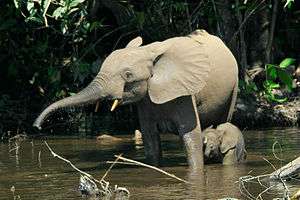
One species of African elephant, the bush elephant, is the largest living terrestrial animal, while the forest elephant is the third largest. Their thickset bodies rest on stocky legs, and they have concave backs.[4] Their large ears enable heat loss.[5] The upper lip and nose form a trunk. The trunk acts as a fifth limb, a sound amplifier, and an important method of touch. African elephants' trunks end in two opposing lips,[6] whereas the Asian elephant trunk ends in a single lip.[6] In L. africana, males stand 3.2–4.0 m (10–13 ft) tall at the shoulder and weigh 4,700–6,048 kg (10,360–13,330 lb), while females stand 2.2–2.6 m (7–9 ft) tall and weigh 2,160–3,232 kg (4,762–7,125 lb);[7] L. cyclotis is smaller with male shoulder heights of up to 2.5 m (8 ft).[8] The largest recorded individual stood four metres (13.1 ft) at the shoulders and weighed 10 tonnes (10 long tons; 11 short tons).[4]
Teeth
Elephants have four molars; each weighs about 5 kg (11 lb) and measures about 30 cm (12 in) long. As the front pair wears down and drops out in pieces, the back pair moves forward, and two new molars emerge in the back of the mouth. Elephants replace their teeth four to six times in their lifetime. At about 40 to 60 years of age, the elephant loses the last of its molars and will likely die of starvation, a common cause of death. African elephants have 24 teeth in total, six on each quadrant of the jaw. The enamel plates of the molars are fewer in number than in Asian elephants.[9]
The elephants' tusks are firm teeth; the second set of incisors become the tusks. They are used for digging for roots and stripping the bark from trees for food; for fighting each other during mating season; and for defending themselves against predators. The tusks weigh from 23–45 kg (51–99 lb) and can be from 1.5–2.4 m (5–8 ft) long. Unlike Asian elephants, both male and female African elephants have tusks.[10] They are curved forward and continue to grow throughout the elephant's lifetime.[6]

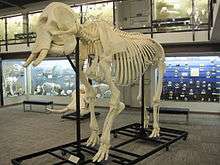
Distribution and habitat
African elephants are found in Eastern, Southern, Central, and West Africa,[11] in dense forests, mopane and miombo woodlands, Sahelian scrub or deserts.[5]
Classification
In 1825, Georges Cuvier named the genus "Loxodonte". An anonymous author romanized the spelling to "Loxodonta", and the International Code of Zoological Nomenclature (ICZN) recognizes this as the proper authority.[1]
- * African bush elephant, Loxodonta africana[1]
- * North African elephant, Loxodonta africana pharaoensis (extinct).
- Presumed subspecies north of the Sahara from the Atlas to Ethiopia.
- * African forest elephant, Loxodonta cyclotis[1]
- * Loxodonta atlantica (fossil). Presumed ancestor of the modern African elephants
- * Loxodonta exoptata (fossil). Presumed ancestor of L. atlantica[2]
- * ? Loxodonta adaurora (fossil) May belong in Mammuthus.


Bush and forest elephants were formerly considered subspecies[12] of Loxodonta africana. As described in the entry for the forest elephant in the third edition of Mammal Species of the World (MSW3),[13] there is morphological and genetic evidence that they should be considered as separate species.[14][15][16]
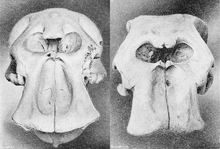
Note the shorter and wider head of L. cyclotis, with a concave instead of convex forehead.
Much of the evidence cited in MSW3 is morphological. The African forest elephant has a longer and narrower mandible, rounder ears, a different number of toenails, straighter and downward tusks, and considerably smaller size. With regard to the number of toenails: the African bush elephant normally has four toenails on the front foot and three on the hind feet, the African forest elephant normally has five toenails on the front foot and four on the hind foot (like the Asian elephant), but hybrids between the two species commonly occur.
MSW3 lists the two forms as full species[1] and does not list any subspecies in its entry for Loxodonta africana.[17] However, this approach is not taken by the United Nations Environment Programme's World Conservation Monitoring Centre nor by the International Union for Conservation of Nature (IUCN), both of which list L. cyclotis as a synonym (not even a subspecies) of L. africana.[18][19] A consequence of the IUCN taking this view is that the IUCN Red List makes no independent assessment of the conservation status of the two forms of African elephant. It merely assesses the two forms taken together, as vulnerable.[18]
A study of nuclear DNA sequences, published in 2010, indicated that the divergence date between forest and savanna elephants was 2.6 – 5.6 million years ago, similar to the divergence date estimated for the Asian elephant and the woolly mammoths (2.5 – 5.4 million years ago), which strongly supports their status as separate species. Forest elephants were found to have a high degree of genetic diversity, perhaps reflecting periodic fragmentation of their habitat during the climatic changes of the Pleistocene.[15]
However, recent DNA sequence analysis indicates that the extinct European straight-tusked elephant, Palaeoloxodon antiquus, is closer to L. cyclotis than L. cyclotis is to L. africana, thus invalidating Loxodonta as currently recognized.[3]
Behavior
African elephant societies are arranged around family units. Each family unit is made up of around ten closely related females and their calves and is led by an older female known as the matriarch.[4] When separate family units bond, they form kinship or bond groups. After puberty, male elephants tend to form alliances with other males.
Elephants are at their most fertile between the ages of 25 and 45.[4] Calves are born after a gestation period of nearly two years. The calves are cared for by their mother and other young females in the group, known as allomothers.[4]
Elephants use some vocalisations that are beyond the hearing range of humans,[20] to communicate across large distances. Elephant mating rituals include the gentle entwining of trunks.[21]
Feeding
While feeding, elephants use their trunks to pluck at leaves and their tusks to tear at branches, which can cause enormous damage to foliage.[6] A herd may deplete an area of foliage depriving other herbivores for a time. African elephants may eat up to 450 kilograms (992 lb) of vegetation per day, although their digestive system is not very efficient; only 40 percent of this food is properly digested.[22] The foregut fermentation used by ruminants is generally considered more efficient than the hindgut fermentation employed by proboscideans and perissodactyls;[23] however, the ability to process food more rapidly than foregut fermenters gives hindgut fermenters an advantage at very large body size, as they are able to accommodate significantly larger food intakes.[24]
Intelligence
African elephants are highly intelligent,[25] and they have a very large and highly convoluted neocortex, a trait they share with humans, apes and some dolphin species. They are amongst the world's most intelligent species. With a mass of just over 5 kg (11 lb), elephant brains are larger than those of any other land animal, and although the largest whales have body masses twenty-fold those of a typical elephant, whale brains are barely twice the mass of an elephant's brain. The elephant's brain is similar to that of humans in terms of structure and complexity. For example, the elephant's cortex has as many neurons as that of a human brain,[26] suggesting convergent evolution.[27]
Elephants exhibit a wide variety of behaviors, including those associated with grief, learning, allomothering, mimicry, art, play, a sense of humor, altruism, use of tools, compassion, cooperation,[28] self-awareness, memory and possibly language.[29] All point to a highly intelligent species that is thought to be equal with cetaceans,[30][31][32][33] and primates.[31][34]
Reproduction
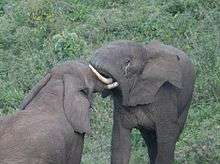
African elephants show sexual dimorphism in weight and shoulder height by age 20, due to the rapid early growth of males; by age 25, males are double the weight of females. However, both sexes continue to grow throughout their lives.
Female African elephants are able to start reproducing at around 10 to 12 years of age,[35] and are in estrus for about 2 to 7 days. They do not mate at a specific time; however, they are less likely to reproduce in times of drought than when water is plentiful. The gestation period of an elephant is 22 months and fertile females usually give birth every 3 – 6 years, so if they live to around 50 years of age, they may produce 7 offspring. Females are a scarce and mobile resource for the males so there is intense competition to gain access to estrous females.
Post sexual maturity, males begin to experience musth, a physical and behavioral condition that is characterized by elevated testosterone, aggression and more sexual activity.[36][37] Musth also serves a purpose of calling attention to the females that they are of good quality, and it cannot be mimicked as certain calls or noises may be. Males sire few offspring in periods when they are not in musth. During the middle of estrus, female elephants look for males in musth to guard them. The females will yell, in a loud, low way to attract males from far away. Male elephants can also smell the hormones of a female ready for breeding. This leads males to compete with each other to mate, which results in the females mating with older, healthier males.[38] Females choose to a point who they mate with, since they are the ones who try to get males to compete to guard them. However, females are not guarded in the early and late stages of estrus, which may permit mating by younger males not in musth.
Males over the age of 25 compete strongly for females in estrous, and are more successful the larger and more aggressive they are.[39] Bigger males tend to sire bigger offspring.[40] Wild males begin breeding in their thirties when they are at a size and weight that is competitive with other adult males. Male reproductive success is maximal in mid-adulthood and then begins to decline. However, this can depend on the ranking of the male within their group, as higher-ranking males maintain a higher rate of reproduction.[41] Most observed matings are by males in musth over 35 years of age. Twenty-two long observations showed that age and musth are extremely important factors; "… older males had markedly elevated paternity success compared with younger males, suggesting the possibility of sexual selection for longevity in this species." (Hollister-Smith, et al. 287).
Males usually stay with a female and her herd for only a few weeks before moving on in search for another mate. Less than a third of the population of female elephants will be in estrus at any given time and gestation period of an elephant is long, so it makes more evolutionary sense for a male to search for as many females as possible rather than stay with one group. Some elephant fetuses will morph together in the womb and create abnormalities with the ears.
Gallery
The following sequence of five images was taken in the Addo Elephant Park in South Africa.
- Elephant mating ritual
-

-
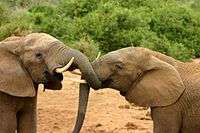
-
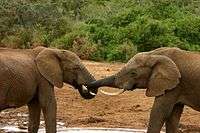
-
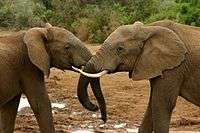
-

Mating in captivity
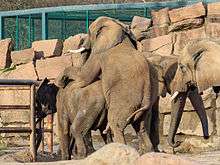
The social behavior of elephants in captivity mimics that of those in the wild. Females are kept with other females, in groups, while males tend to be separated from their mothers at a young age, and are kept apart. According to Schulte, in the 1990s, in North America, a few facilities allowed male interaction. Elsewhere, males were only allowed to smell each other. Males and females were allowed to interact for specific purposes such as breeding. In that event, females were more often moved to the male than the male to the female. Females are more often kept in captivity because they are easier and less expensive to house.[42]
Conservation

Population estimates and poaching
During the 20th century, poaching significantly reduced the population of Loxodonta in some regions. The World Wide Fund for Nature believes there were between 3 and 5 million African elephants as recently as the 1930s and 1940s.[43] Between 1980 and 1990 the population of African elephants was more than halved, from 1.3 million to around 600,000.[44][45] Between 1973 and 1989, the African elephant population of Kenya declined by 85%.[11] In Chad, the population declined from 400,000 in 1970 to about 10,000 in 2006. The population in the Tanzanian Selous Game Reserve, once the largest of any reserve in the world, dropped from 109,000 in 1976 to 13,000 in 2013.[46] 85,000 elephants were lost to poaching in Tanzania between 2009 and 2014.[47]
In 1989, CITES (Convention on International Trade in Endangered Species of Wild Fauna and Flora) banned international trade in ivory to fight this massive illegal trade. After the ban came into force in 1990, major ivory markets were eliminated. As a result, African elephant populations experienced a decline in illegal killing, particularly where they were appropriately protected. This allowed some elephant populations to recover. Nevertheless, within countries where wildlife management authorities are greatly under-funded, poaching is still a significant problem.
The World Wildlife Foundation states that the two threats that impact African elephants the most are the demand for ivory and changes in land usage. The majority of the ivory leaving Africa continues to be acquired and transported illegally, and over 80% of all the raw ivory traded comes from poached African elephants. From 2006 to 2012 the magnitude of poaching increased (including some 3,000 elephants slaughtered in between 2006 and 2009). In an incident lasting a few days in February 2012 in Bouba N'Djida park in Cameroon, 650 elephants were poached. In early March 2013 in Chad, 86 elephants — including 33 pregnant females — were killed in "a potentially devastating blow to one of central Africa's last remaining elephant populations."[48] By 2014 it was estimated that only 50,000 elephants remained in Central Africa. The last major populations are present in Gabon and the Republic of Congo.[46]
According to the World Wildlife Fund, in 2014 the total population of African elephants was estimated to be around 700,000, and the Asian elephant population was estimated to be around 32,000. The population of African elephants in Southern Africa is large and expanding, with more than 300,000 within the region; Botswana has 200,000 and Zimbabwe 80,000. Large populations of elephants are confined to well-protected areas. However, conservative estimates were that 23,000 African elephants were killed by poachers in 2013[46] and less than 20% of the African elephant range was under formal protection.[49] By contrast a study published by the BBC suggests there are about 415,000 elephants in Africa and the population declined by 30% in the last 7 years.[50]
Between the African elephants and the Asian elephants there is a large variance in genetics; also, within Africa the different species vary in genetics based on where they live. The two African species, Loxodonta africana and Loxodonta cyclotis, share different gene flow and have limited hybridization with each other.[51]
When examining the gene flow between the forest and savanna elephants, observers look at 21 distinct locations. The evidence points to the fact that there was ancient hybridization since the species share a small amount of similar DNA.[52]
Legal protections and conservation status
Protection of African elephants is a high-profile conservation cause in many countries. In 1989, the Kenyan Wildlife Service burned a stockpile of tusks in protest against the ivory trade.[53] However, African elephant populations can be devastated by poaching despite nominal governmental protection,[54] and some nations permit the hunting of elephants for sport.[6] In 2012, The New York Times reported a large upsurge in ivory poaching, with about 70% of the product flowing to China.[55]
Conflicts between elephants and a growing human population are a major issue in elephant conservation.[11] Human encroachment into natural areas where bush elephants occur or their increasing presence in adjacent areas has spurred research into methods of safely driving groups of elephants away from humans. Playback of the recorded sounds of angry honey bees has been found to be remarkably effective at prompting elephants to flee an area.[56] The International Union for Conservation of Nature (IUCN) African elephant specialist group has set up a human-elephant conflict working group. They believe that different approaches are needed in different countries and regions, and so develop conservation strategies at national and regional levels.[57]
Under the auspices of the Convention on Migratory Species of Wild Animals (CMS), also known as the Bonn Convention, a Memorandum of Understanding concerning Conservation Measures for the West African Populations of the African Elephant came into effect on 22 November 2005. The MoU aims to protect the West African elephant population by providing an international framework for state governments, scientists and conservation groups to collaborate in the conservation of the species and its habitat.
China was the biggest market for poached ivory but announced they would phase out the legal domestic manufacture and sale of ivory products in May, 2015, and in September 2015 China and the U.S.A. "said they would enact a nearly complete ban on the import and export of ivory."[58]
The International Union for Conservation of Nature released a report that Africa's elephant population is 415,000. They report that in the past decade, this is a decline of 111,000 elephants. This is reported as the worst decline in the past 25 years.[59]
References
This article incorporates text from the ARKive fact-file "African elephant" under the Creative Commons Attribution-ShareAlike 3.0 Unported License and the GFDL.
- 1 2 3 4 5 6 Shoshani, J. (2005). "Genus Loxodonta". In Wilson, D.E.; Reeder, D.M. Mammal Species of the World: A Taxonomic and Geographic Reference (3rd ed.). Johns Hopkins University Press. p. 91. ISBN 978-0-8018-8221-0. OCLC 62265494.
- 1 2 Kalb, Jon E.; Mebrate, Assefa (1993). Fossil Elephantoids from the Hominid-Bearing Awash Group, Middle Awash Valley, Afar Depression, Ethiopia. Independence Square, Philadelphia: The American Philosophical Society. pp. 52–59. ISBN 0-87169-831-5.
- 1 2 Callaway, E. (2016-09-16). "Elephant history rewritten by ancient genomes". Nature. doi:10.1038/nature.2016.20622.
- 1 2 3 4 5 Macdonald, D. (2001). The New Encyclopedia of Mammals. Oxford: Oxford University Press.
- 1 2 Nowak, R.M. (1999). Walker's Mammals of the World. Baltimore and London: The Johns Hopkins University Press.
- 1 2 3 4 5 Burnie, D. (2001). Animal. London: Dorling Kindersley.
- ↑ Laurson, Barry; Bekoff, Marc (1978). "Loxodonta africana" (PDF). Mammalian Species. 92: 1–8. doi:10.2307/3503889. Retrieved 5 August 2010.
- ↑ "Forest elephant videos, photos and facts – Loxodonta cyclotis". ARKive. 2006-09-02. Retrieved 28 March 2014.
- ↑ Clutton-Brock, Juliet (1987). A Natural History of Domesticated Mammals. p. 208. ISBN 0-521-34697-5.
- ↑ Asian Elephant. Denver Zoo
- 1 2 3 Blanc, J. J.; Thouless, C. R.; Hart, J. A.; et al. (2003). African Elephant Status Report 2002: An update from the African Elephant Database (PDF). IUCN, Gland and Cambridge.
- ↑ Estes, Richard D. (1999). The Safari Companion. Chelsea Green Publishing Company. p. 223. ISBN 1-890132-44-6.
- ↑ Shoshani, J. (2005). "Loxodonta cyclotis". In Wilson, D.E.; Reeder, D.M. Mammal Species of the World: A Taxonomic and Geographic Reference (3rd ed.). Johns Hopkins University Press. p. 91. ISBN 978-0-8018-8221-0. OCLC 62265494.
- ↑ Rohland, Nadin; Malaspinas, Anna-Sapfo; Pollack, Joshua L.; Slatkin, Montgomery; Matheus, Paul; Hofreiter, Michael (2007). "Proboscidean Mitogenomics: Chronology and Mode of Elephant Evolution Using Mastodon as Outgroup". PLoS Biology. 5 (8): e207. doi:10.1371/journal.pbio.0050207. PMC 1925134
 . PMID 17676977.
. PMID 17676977. - 1 2 Rohland, Nadin; Reich, David; Mallick, Swapan; Meyer, Matthias; Green, Richard E.; Georgiadis, Nicholas J.; Roca, Alfred L.; Hofreiter, Michael (2010). "Genomic DNA sequences from mastodon and woolly mammoth reveal deep speciation of forest and savanna elephants". PLoS Biology. 8 (12): e1000564. doi:10.1371/journal.pbio.1000564. PMC 3006346
 . PMID 21203580.
. PMID 21203580. - ↑ Murphy, W. J.; Ishida, Y.; Oleksyk, T. K.; Georgiadis, N. J.; David, V. A.; Zhao, K.; Stephens, R. M.; Kolokotronis, S.-O.; Roca, A. L. (2011). "Reconciling Apparent Conflicts between Mitochondrial and Nuclear Phylogenies in African Elephants". PLoS ONE. 6 (6): e20642. Bibcode:2011PLoSO...620642I. doi:10.1371/journal.pone.0020642. PMC 3110795
 . PMID 21701575.
. PMID 21701575. - ↑ Shoshani, J. (2005). "Loxodonta africana". In Wilson, D.E.; Reeder, D.M. Mammal Species of the World: A Taxonomic and Geographic Reference (3rd ed.). Johns Hopkins University Press. p. 91. ISBN 978-0-8018-8221-0. OCLC 62265494.
- 1 2 Blanc, J. (2008). "Loxodonta africana". IUCN Red List of Threatened Species. Version 2010.1. International Union for Conservation of Nature. Retrieved 10 June 2010.
- ↑ UNEP-WCMC database entry for Loxodonta cyclotis. Unep-wcmc.org. Retrieved 28 June 2013.
- ↑ Herbst, C. T.; Stoeger, A. S.; Frey, R.; Lohscheller, J.; Titze, I.; Gumpenberger, M.; Fitch, W. T. (2012). "How Low Can You Go? Physical Production Mechanism of Elephant Infrasonic Vocalizations". Science. 337: 595–599. doi:10.1126/science.1219712.
- ↑ Buss, Irven; Smith, Norman (1966). Observations on Reproduction and Breeding Behavior of the African Elephant (PDF). Allen Press.
- ↑ Animals of the Amboseli National Park. amboselinationalpark.co.uk
- ↑ Animal Structure & Function. Sci.waikato.ac.nz. Retrieved 2011-11-27
- ↑ Clauss, M.; Frey, R.; Kiefer, B.; Lechner-Doll, M.; Loehlein, W.; Polster, C.; Roessner, G. E.; Streich, W. J. (2003-04-24). "The maximum attainable body size of herbivorous mammals: morphophysiological constraints on foregut, and adaptations of hindgut fermenters". Oecologia. 136 (1): 14–27. doi:10.1007/s00442-003-1254-z. PMID 12712314. Retrieved 2012-01-08.
- ↑ Aldous, Peter (2006-10-30). "Elephants see themselves in the mirror". New Scientist. Retrieved 29 August 2010.
- ↑ Roth, Gerhard; Stamenov, Maxim I.; Gallese, Vittorio. "Is the human brain unique?". Mirror Neurons and the Evolution of Brain and Language. John Benjamins Publishing. pp. 63–76. doi:10.1002/0470867221.ch2. ISBN 978-0-470-84960-6.
- ↑ Goodman, M.; Sterner, K.; Islam, M.; Uddin, M.; Sherwood, C.; Hof, P.; Hou, Z.; Lipovich, L.; Jia, H.; Grossman, L.; Wildman, D. (19 November 2009). "Phylogenomic analyses reveal convergent patterns of adaptive evolution in elephant and human ancestries". Proceedings of the National Academy of Sciences. 106 (49): 20824–20829. Bibcode:2009PNAS..10620824G. doi:10.1073/pnas.0911239106. PMC 2791620
 . PMID 19926857.
. PMID 19926857. - ↑ "Elephants know when they need assistance in a cooperative task". PNAS. Retrieved 8 March 2011.
- ↑ Parsell, D. L. (2003-02-21). "In Africa, Decoding the 'Language' of Elephants". National Geographic News. Archived from the original on 12 October 2007. Retrieved 30 October 2007.
- ↑ Viegas, Jennifer (2011). "Elephants smart as chimps, dolphins". ABC Science. Retrieved 8 March 2011.
- 1 2 Viegas, Jennifer (2011). "Elephants Outwit Humans During Intelligence Test". Discovery News. Archived from the original on 8 March 2011. Retrieved 19 March 2011.
- ↑ "What Makes Dolphins So Smart?". The Ultimate Guide: Dolphins. 1999. Archived from the original on 14 May 2008. Retrieved 30 October 2007.
- ↑ "Mind, memory and feelings". Friends Of The Elephant. Archived from the original on 10 March 2008. Retrieved 20 December 2007.
- ↑ Scott, David (2007-10-19). "Elephants Really Don't Forget". Daily Express. Retrieved 30 October 2007.
- ↑ Benedict, F. G. (1936). "The physiology of the elephant". Carnegie Inst. Washington Pub. No. 474. 1.
- ↑ Hollister-Smith, Julie A.; Poole, Joyce H.; Archie, Elizabeth A.; Vance, Eric A.; Georgiadis, Nicholas J.; Moss, Cynthia J.; Alberts, Susan C. (2007). "Age, musth, and paternity success in wild male African elephants, Loxodonta africana" (PDF). Animal Behaviour. 74 (2): 287. doi:10.1016/j.anbehav.2006.12.008.
- ↑ Sukumar, Raman. The Living Elephants: Evolutionary Ecology, Behavior, and Conservation. New York: Oxford University Press, Inc. p. 112. ISBN 0-19-510778-0.
- ↑ Poole, Joyce H. (1989). "Mate guarding, reproductive success and female choice in African elephants". Animal Behaviour. 37: 842–849. doi:10.1016/0003-3472(89)90068-7.
- ↑ Sukumar, Raman (2003). The Living Elephants: Evolutionary Ecology, Behavior, and Conservation. New York: Oxford University Press, Inc. pp. 112–124. ISBN 0-19-510778-0.
- ↑ Lee, Phyllis C.; Moss, Cynthia J. (1986). "Early maternal investment in male and female African elephant calves". Behavioral Ecology and Sociobiology. 18 (5): 353–361. doi:10.1007/bf00299666.
- ↑ Loizi, Helen; Goodwin, T. E.; Rasmussen, L. E. L.; Whitehouse, A. M.; Schulte, B. A. (2009). "Sexual dimorphism in the performance of chemosensory investigatory behaviours by African elephants (Loxodonta africana)". Behaviour. 146 (3): 373–392. doi:10.1163/156853909X410964.
- ↑ Schulte, Bruce A. (2000). "Social structure and helping behavior in captive elephants". Zoo Biology. 19 (5): 447–459. doi:10.1002/1098-2361(2000)19:5<447::aid-zoo12>3.0.co;2-#.
- ↑ "African Elephants". World Wildlife Foundation. Retrieved 7 April 2014.
- ↑ Thornton, Allan and Currey, Dave (1991) To Save An Elephant. Doubleday. ISBN 0-385-40111-6
- ↑ "A System of Extinction – the African Elephant Disaster". Environmental Investigation Agency. 1989
- 1 2 3 Vira, Varun and Ewing, Thomas (April 2014) Ivory's Curse Born Free USA and C4ADS. Retrieved 16 May 2014
- ↑ "The "Queen of Ivory" arrested in Tanzania". Elephant Action League. 8 October 2015. Retrieved 12 October 2015.
- ↑ 86 elephants killed in Chad poaching massacre. Guardian (2013-03-19). Retrieved 28 June 2013.
- ↑ "Endangered species" Panda.org website.
- ↑ New report confirms grim outlook for elephants BBC
- ↑ Roca, A. L.; Georgiadis, N.; Pecon-Slattery, J.; O'Brien, S. J. (2001). "Genetic Evidence for Two Species of Elephant in Africa". Science. 293 (5534): 1473–1477. Bibcode:2001Sci...293.1473R. doi:10.1126/science.1059936. PMID 11520983.
- ↑ Roca, A. L.; Georgiadis, N.; O'Brien, S. J. (2004-12-12). "Cytonuclear genomic dissociation in African elephant species". Nature Genetics. 37 (1): 96–100. doi:10.1038/ng1485. PMID 15592471.
- ↑ Poole, Joyce (1996). Coming of Age With Elephants. New York: Hyperion. p. 232. ISBN 0-7868-6095-2.
- ↑ Goudarzi, Sara (2006-08-30). "100 Slaughtered Elephants Found in Africa". LiveScience.com. Archived from the original on 3 September 2006. Retrieved 31 August 2006.
- ↑ Gettleman, Jeffrey (3 September 2012). "Elephants Dying in Epic Frenzy as Ivory Fuels Wars and Profits". The New York Times.
- ↑ King, Lucy E.; Douglas-Hamilton, Iain; Vollrath, Fritz (2007). "African elephants run from the sound of disturbed bees". Current Biology. 17 (19): R832–3. doi:10.1016/j.cub.2007.07.038. PMID 17925207.
- ↑ "IUCN African Elephant Specialist Group". February 2006. Retrieved 13 July 2011.
- ↑ Fergus Ryan. "China and US agree on ivory ban in bid to end illegal trade globally". the Guardian.
- ↑ "Poaching behind worst African elephant losses in 25 years – IUCN report" 23 September 2016.https://www.iucn.org/news/poaching-behind-worst-african-elephant-losses-25-years-%E2%80%93-iucn-report
External links
| Wikimedia Commons has media related to African elephant. |
- African elephant media at ARKive
- CMS West African Elephant Memorandum of Understanding
- Elephant Information Repository – An in-depth resource on elephants
- "Elephant caves" of Mt Elgon National Park
- ElephantVoices – Resource on elephant vocal communications
- Amboseli Trust for Elephants – Interactive web site
- Another Elephant – A hub for saving the elephants.
- David Quammen: " Family ties – The elephants of Samburu" National Geographic Magazine September 2008 link
- EIA 25 yrs investigating the ivory trade, reports etc
- EIA (in the USA) reports etc
- International Elephant Foundation